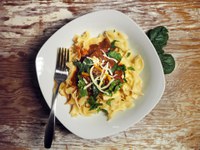Prairie Fare: Should You Keep or Toss Foods Beyond the Package Date?
(Click an image below to view a high-resolution image that can be downloaded)
By Julie Garden-Robinson, food and nutrition specialist
NDSU Extension
“Mom, I found some curry paste in my cupboard,” my son texted.
“It’s three years past the date on the package. Can I use it?” he asked.
He added “LOL” (laughing out loud) at the end of his text.
I am sure he knew my answer.
“Throw it,” I replied.
I think I texted him a bug-eyed cartoon.
I don’t like the idea of throwing food, but after three years, both quality and potentially safety could be issues.
He had offered to make me curry next time he comes home. I will be checking his food package dates. I’ll text him that with an “LOL.”
I’m not sure if my two young adults conspired to ask me questions that day.
“Mom, is it OK to eat yogurt that’s a week past its date? It looks and smells OK,” my daughter asked.
“Yes, you can eat it,” I replied.
In fact, yogurt is fine one to two weeks beyond the date, if stored at refrigerator temperature.
My kids must be spring cleaning their cupboards and refrigerators, I thought to myself.
Taking stock of the food you have on hand is a good practice. Plan your meals taking into account the food you have on hand so you are not surprised by food past the product date.
Use your senses, except taste, to help you decide what is safe to consume. Remember the most dangerous microorganisms and their toxins have no off-aromas or flavors.
Food product dates help guide us to the best quality, but food dates are not required on most packaged foods. The Food and Drug Administration (FDA) is working with the food industry to standardize “Best if Used By” on product packages.
With the exception of baby food, you can use most food a while beyond the date on the package as long as it is stored safely.
To avoid food waste, be a scientist and monitor temperature and time of your refrigerated and frozen products.
Refrigerators should maintain food at 40 degrees Fahrenheit or lower, and freezers should keep food solidly frozen at 0 degrees Fahrenheit.
Food in your freezer will remain “safe” to eat as long as it remains solidly frozen; however, you might not want to eat the food due to quality losses.
Freezer-burn is a quality issue. Freezer-burned food is dehydrated and may have off-colors, off-flavors and a grayish, leathery texture.
While you probably won’t get sick eating freezer-burned food, you won’t get any compliments from your family on the tasty meatloaf.
To avoid freezer burn, place meat products in air-tight packaging such as freezer bags or overwrap with butcher paper or heavy aluminum foil. Vacuum packaging also extends freezer life.
Be sure to list the date of purchase on the package.
For pantry foods, such as dry goods and canned goods, write your date of purchase on the front and then rotate your stock as you put away groceries or organize your cupboards. Put the oldest food in the front of your cupboard so you use it first.
According to the U.S. Department of Agriculture (USDA), you can store canned acidic food (tomatoes, fruit) for about 18 months and canned low-acid food (vegetables, beans) for five years. The Canned Food Alliance suggests a rule of thumb: use all canned food within two years of purchase.
We at NDSU Extension have many food safety resources, including a “Food Storage Guide” and a “Food Freezing Guide.” Visit www.ag.ndsu.edu/food and search the titles online.
If you use apps on your mobile device, download the “FoodKeeper App” from USDA. See www.foodsafety.gov/keep-food-safe/foodkeeper-app to learn more.
Take a look at your cupboards and refrigerator. You might have the makings for this recipe, which is courtesy of the Canned Food Alliance (www.mealtime.org). You could swap in your favorite type of canned beans. The recipe called for dry white wine, but you could use vegetable or chicken broth in its place.
Tuscan-style Pasta with Cannellini Beans
1 pound ziti or penne pasta or other pasta
1/4 cup olive oil
5 large garlic cloves, finely chopped (or 5 teaspoons minced garlic, available in jars)
1/4 pound curly escarole, sliced or 1 small bunch arugula or 4 ounces spinach
1 16-ounce can cannellini beans, drained and rinsed, reduced sodium
1 14 ½-ounce can diced tomatoes with juice, undrained, reduced sodium
2/3 cup dry white wine or broth (chicken or vegetable)
Salt and freshly ground pepper, to taste
1/4 cup fresh basil leaves, thinly sliced
Parmesan cheese (if desired)
Cook pasta according to the package directions. Heat oil in a large skillet over medium-high heat. Add garlic and cook until slightly browned (less than a minute). Add escarole, arugula or spinach, stirring occasionally until wilted, about 2 minutes. Add beans, tomatoes with their juice and wine or broth. Simmer 5 minutes, stirring occasionally. Season to taste with salt and pepper; stir in basil and heat through. Drain pasta and toss with the sauce. Sprinkle with parmesan cheese if desired.
Makes eight servings. Without added salt, each serving has 350 calories, 8 grams (g) fat, 12 g protein, 57 g carbohydrate, 6 g fiber and 190 milligrams sodium.
(Julie Garden-Robinson, Ph.D., R.D., L.R.D., is a North Dakota State University Extension food and nutrition specialist and professor in the Department of Health, Nutrition and Exercise Sciences. Follow her on Twitter @jgardenrobinson)
NDSU Agriculture Communication – March 3, 2022
Source: Julie Garden-Robinson, 701-231-7187, julie.garden-robinson@ndsu.edu
Editor: Elizabeth Cronin, 701-231-5391, elizabeth.cronin@ndsu.edu




